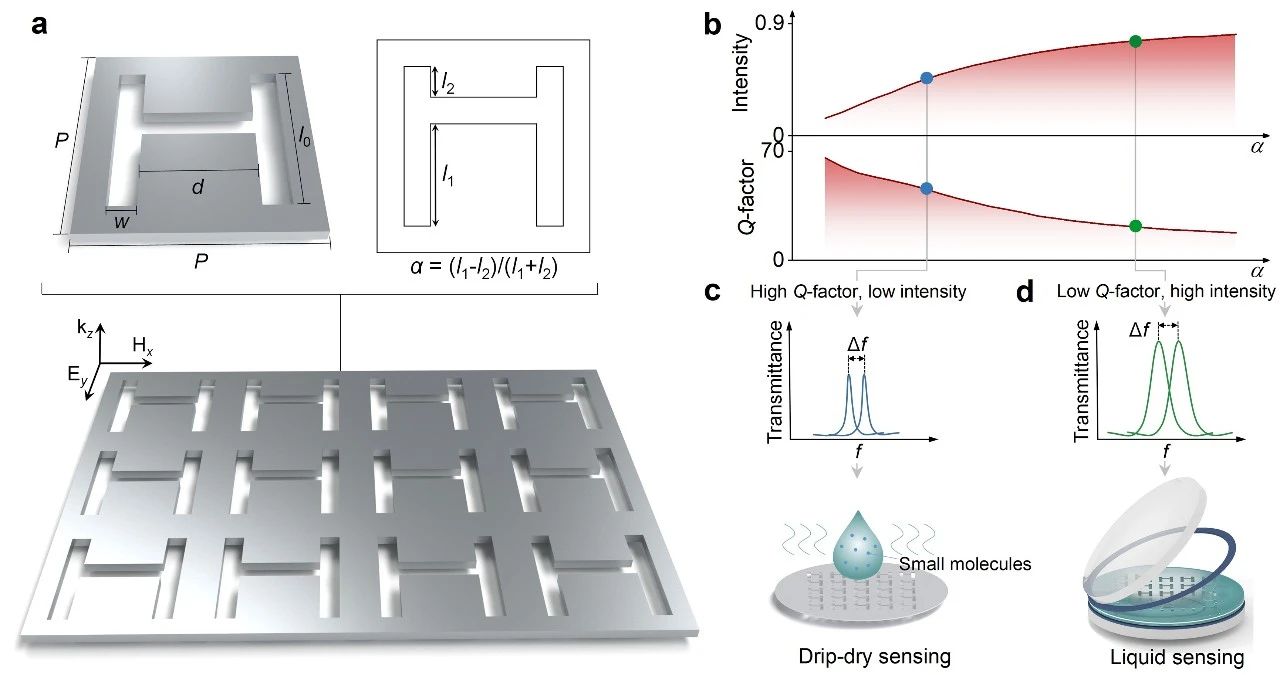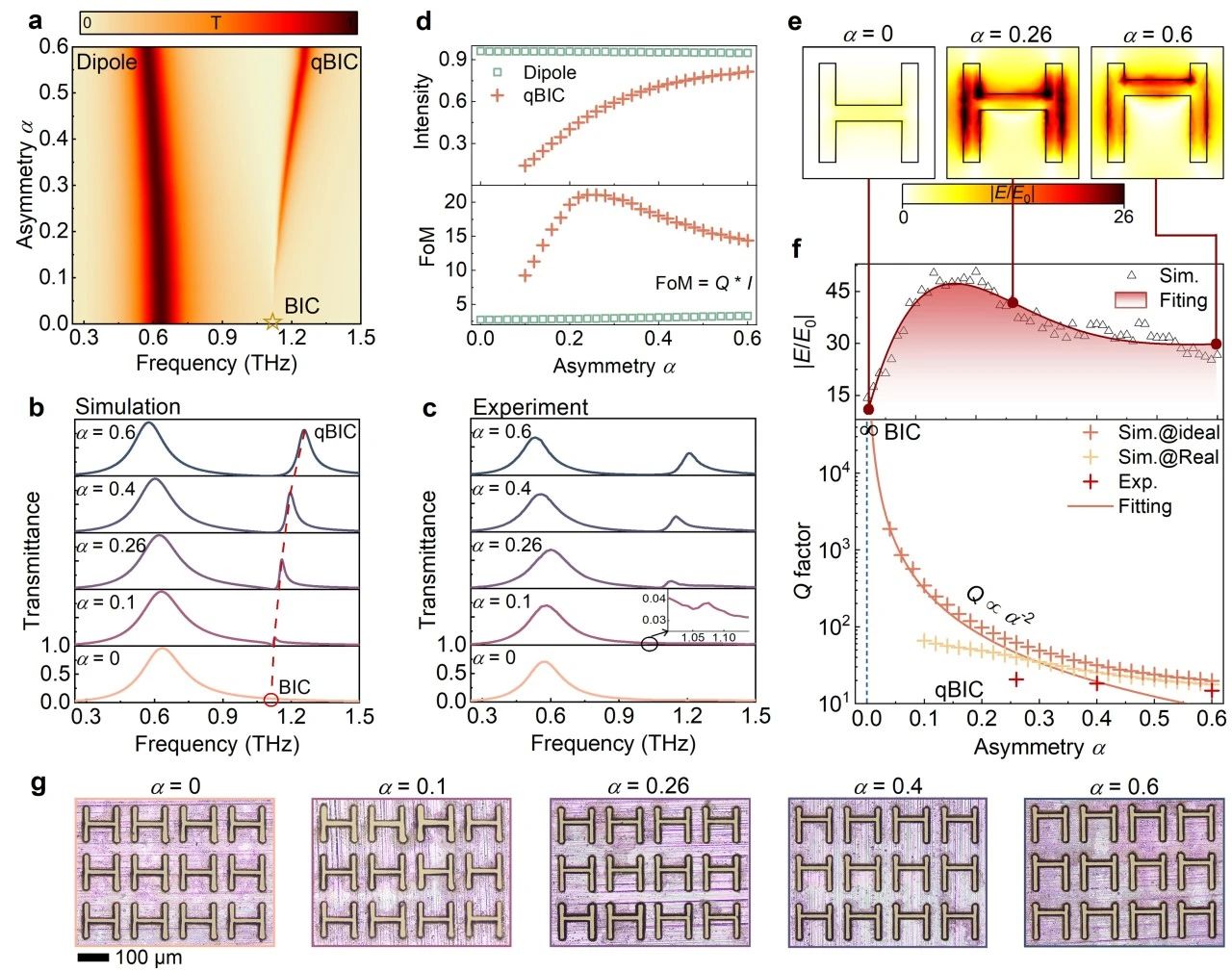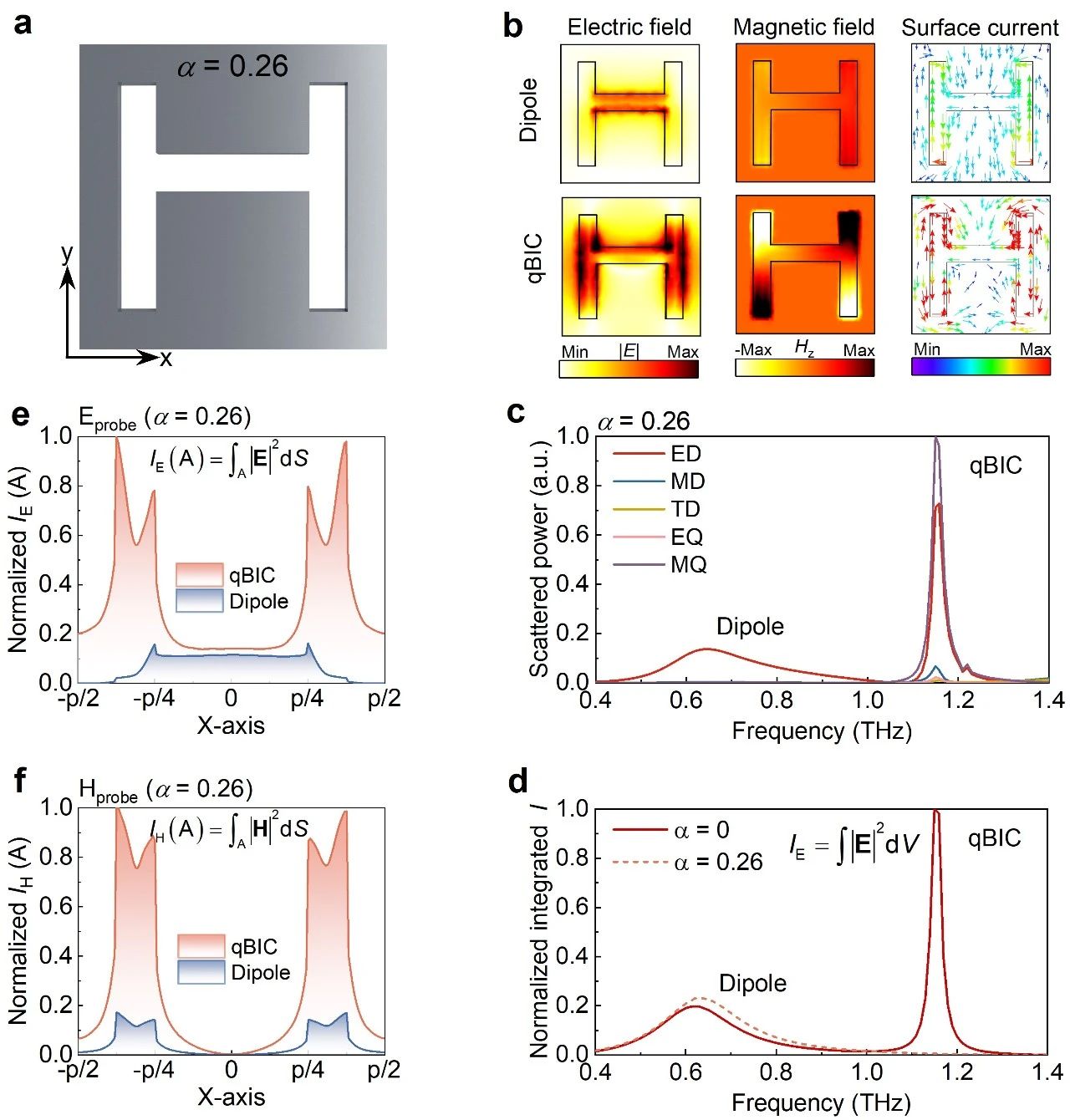一、导读
基于连续体准束缚态 (qBIC) 且具有可操纵共振质量 ( Q ) 因子的超材料为尖端太赫兹传感应用提供了一个出色的平台。然而,到目前为止,大多数都是作为具有相邻基底层的传统金属贴片结构来实现的,招致由于基底效应而导致的光与物质相互作用不足的限制。
2024年8月,福建省太赫兹功能器件与智能传感重点实验室在国际知名光学期刊《Advanced Optical Materials》(中科院2区,IF:8)发表了题为“Substrate-Free Terahertz Metamaterial Sensors With Customizable Configuration and High Performance”的文章。论文提出了一种由qBIC驱动的无基底金属孔径结构超材料,用于定制光与物质的相互作用并表现出近乎理想的传感性能。实验室2021级博士研究生林廷玲为本论文的第一作者,2022级博士研究生曾秋铭为本论文的共同第一作者,实验室主任钟舜聪教授和实验室黄异老师是本文的共同通讯作者。
二、内容简介
本研究提出的金属孔阵列超材料(MHAM)由飞秒激光蚀刻在铝膜上的H型单元阵列组成,其中结构的不对称性通过中心棒偏差的程度来控制,从而直接控制共振线宽和强度。因此,我们构建了一个精确按需定制的MHAM,以在各种条件下执行折射率传感。具体来说,在追求高性能滴干传感时,高Q值的共振是有利的;相反,具有高吸收损耗的液体检测需要高强度低Q值的共振。

Figure 1.Tailored sensing applications with BIC MHAMs. a) Schematic illustration of the H-type symmetry-protected BIC metamaterial and the geometrical parameters of the unit cell. The parameters are fixed as:P= 160 μm,w= 20 μm,d= 80 μm,l0= 120 μm. Crossbar is placed at the center of the unit cell. Offsetting the crossbar upwards to break the asymmetry of the structure, which is defined asα= (l1-l2)/(l1+l2). b) Tuningαallows for precise control over theQfactor and intensity of the qBIC resonance, with a trade-off between them. c) Tailoring highQfactor and low intensity qBIC resonance for drop-dry detection of molecules. d) LowQfactor and high intensity resonance for high absorption liquid detection.
MHAM的实验结果显示其激发了在较高频段的qBIC共振以及较低频段的偶极子共振,与模拟结果极其吻合。其中,qBIC共振可调的特性可用于定制所需的共振,通过品质因数FOM找到了最佳的共振强度和Q值。

Figure 2.Symmetry-protected qBIC resonances of the MHAM. a) Color-coded simulated transmittance map of the MHAM as a function of asymmetry parameterαand frequency. b) Individual transmittance spectra were taken from the resonance map in (a). c) Corresponding measured transmittance spectra for differentα. d) Dependence of the resonance intensity and figure of merit (FoM) of dipole and qBIC modes on the asymmetry parameterα, where FoM =Q*I. e) Electric field distributions of individual unit cells with different asymmetry parameters (α = 0, 0.26, 0.6). f)Qfactors as a function of the asymmetry parameterαin the ideal case with perfect electrical conductor, the real case with metallic aluminum, and experimental measurements. Extracted values of electric field enhancement for the real case. g) Microscope images of MHAM with different asymmetry parameters.
以最优不对称点(α = 0.26)解析了MHAM的光学场约束与多极分解。结果显示出qBIC共振具有更高场强度以及更大范围的场分布,将提供更多的机会与分析物的重叠在随机分布的分子传感中。

Figure 3.Field distribution and multipole decomposition of the MHAM (α= 0.26). a) MHAM unit cell at the optimal asymmetry point. b) Electric field, z-component of magnetic field, and surface current distribution of dipole and qBIC resonances. c) Calculated scattering power of different multipole moments including: electric dipole (ED), magnetic dipole (MD), toroidal dipole (TD), electric quadrupole (EQ), and magnetic quadrupole (MQ). d) Normalized integrated electric field strength of the entire unit resonator atα= 0 and 0.26. e, f) Normalized electric (e) and magnetic (f) field strengths along the x-axis for dipole and qBIC resonances at different cross sections.
以更大不对称性(α = 0.6)的MHAM用于液体传感,其具有更强的谐振强度和较低的Q值可用于收集具有足够对比度的共振信号以进行有效识别在经过吸收衰减后。通过搭载液体样品池并以酒精来表征了MHAM的折射率传感能力,实验结果显示qBIC共振显示出极高的传感灵敏度高达0.86 THz/RIU,远高于最新报道的先进太赫兹超材料传感器。

Figure 4.Refractive index sensing using MHAM with a larger asymmetry (α= 0.6). a) Schematic illustration of metamaterials sensing using a liquid sample cell. The alcohol is transferred onto the surface of MHAM using a pipette, and integrated between the spacer and TPX window for liquid sensing. b) Cross-section diagram of the liquid sample cell, where the thickness of the liquid is controlled by the spacers, and the excess liquid is expelled by tightening the lock nut. c) Simulated frequency shifts of dipole and qBIC resonances for different spacer thicknesses (t) based on different asymmetry parameters, wherenenv. = 1.45. d) Experimental transmittance spectra in response to alcohol with differentt. e) Amplified version of dipole and qBIC resonances responding to different volumes of alcohols. f) Experimental frequency shifts of dipole and qBIC resonances for differentt, using the larger asymmetry MHAM (α= 0.6). g) Comparison ofS, SFoM, andQfactor for THz metamaterial sensors.
接着以最优不对称点(α = 0.26)来验证所设计的MHAM具有的生物分子传感能力,以 L-脯氨酸作为检测目标,采用滴干检测的方法,实验结果显示qBIC共振可以识别低至0.87nmol的目标分析物,比传统偶极子共振低两个数量级。清晰的显微成像图显示分子会随着蒸发过程随机卡在孔径中,结合上方的场分析证实了具有更大更广的场分布的qBIC共振具有更优的传感性能。

Figure 5.Biomolecular sensing using MHAM with optimal asymmetry (α= 0.26). a) Transmittance spectra of the sensor for different concentrations of Pro molecules. The inset gives the corresponding structure. b) Extracted frequency shifts of dipole and qBIC resonances. c) The random distribution of Pro molecules on the MHAM surface with the evaporation process. The red and blue regions represent the presence and absence of molecule distribution, respectively, forming a distinct boundary. d) Enlarged version of a single unit cell reveals the distribution regularity of molecules, with the majority of them being trapped within the apertures.
三、总结
论文通过实验证明了由BIC驱动的太赫兹MHAM,并应用于生物分子的检测。超材料器件具有优越的传感性能,并结合飞秒激光加工技术,其精度与太赫兹亚波长微结构相匹配,实现了快速器件加工。超材料结构由H形阵列组成,通过调制不对称性将BIC转换为具有增强局部场和灵活可调性的qBIC。利用这种可调特性,实现了基于低Q因子和大不对称下高强度共振的液体传感表征。这种接近理想的超材料传感器实现了高达0.86THz/RIU的实验灵敏度,是传统偶极子共振的1.9倍,大大超过了报道的同类传感器。此外,优化后的qBIC共振检测Pro分子的水平低两个数量级比偶极子共振,低至0.01 mg mL−1。因此,本研究展示了基于可调谐qBIC超材料的潜力,通过定制光-物质相互作用,用于尖端光学传感应用。

原文链接:https://doi.org/10.1002/adom.202400689